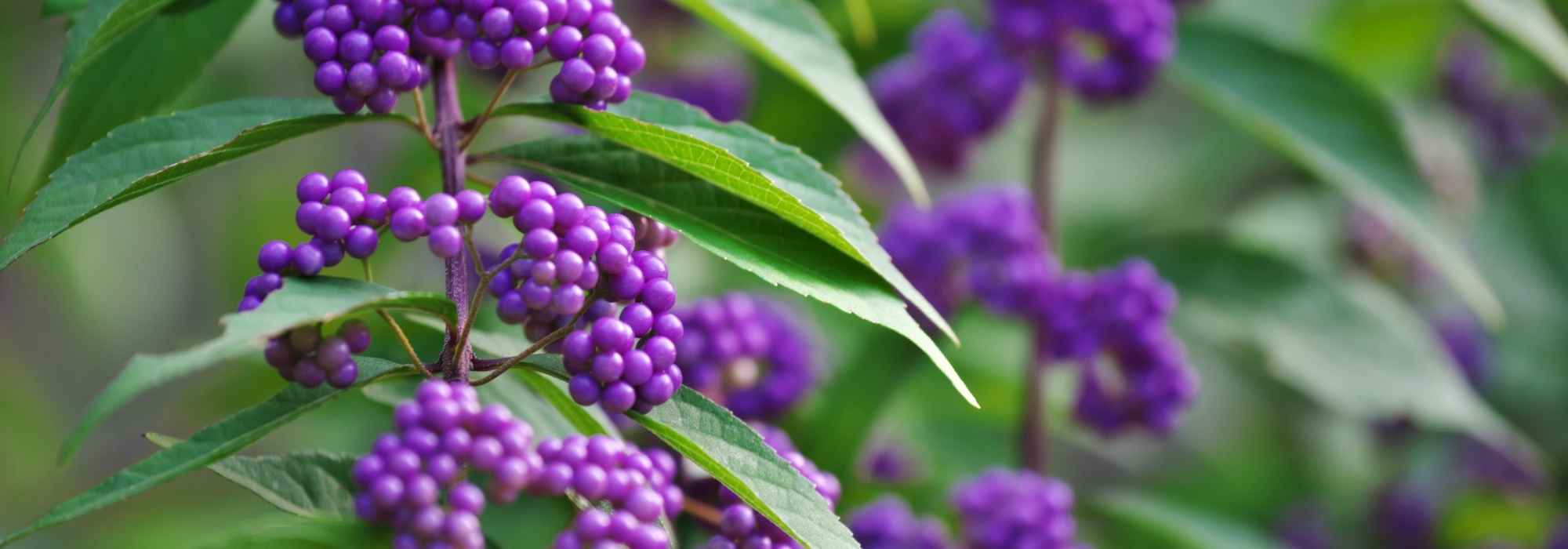
Callicarpa: 5 pairing ideas
For the 4 seasons
Contents
Callicarpa or candy bush is a remarkable deciduous shrub that boasts numerous advantages. It reveals itself in autumn with its beautiful foliage in changing and vibrant tones, as well as its clusters of lovely round and shiny berries, white or most often purple, which persist through winter. In addition to this decorative fruiting that adds colour and whimsy to the garden in autumn and winter, it also offers a lovely summer flowering, with small cymes of white or purplish-pink flowers.
Upright and bushy, the Callicarpa reaches a height of about 3 m and a spread of 1.5 m at maturity.
It is a very hardy and accommodating shrub once well established, never suffering from disease, and it thrives in full sun or partial shade, in ordinary soil that is not too dry in summer.
From summer to winter, it is perfect for creating scenes with vibrant tones.
Discover some easy-to-reproduce arrangements to create 5 different but all bright atmospheres!
Anti-gloom plan to brighten up winter
Callicarpa is one of those shrubs that will amaze with the spectacular colour of its fruiting. It is when everything is bare in the garden that, at the end of the year, it offers brightly coloured berries with high decorative potential. In autumn, from October onwards, it is covered with a profusion of small, shiny, round pearls, resembling sweets, often in shades of pink, lilac-pink, or violet, and more rarely white. Lasting long, at least until January, they adorn its bare branches and brighten the dreary days of early winter.
Create contrasts with complementary colours by pairing a Callicarpa with purple fruits like Callicarpa bodinieri ‘Imperial Pearl’ with the bright orange berries of a Pyracantha ‘Saphyr Orange®’ or with the spider flowers of a Witch Hazel.
Enhance the palette of purple shades by planting a low-growing, carpet-forming Symphorine at its base, such as the cultivar ‘Hancock’. These combinations will draw attention in autumn and winter with their abundant, colourful fruiting.
For softer combinations in early winter, choose the Callicarpa dichotoma ‘Albicacca’, for example, which is a variety with pure white berries. It easily integrates into a free-form hedge or a large, unpretentious shrub mass, natural in style. Opt for varieties of Symphorines with pearlescent pink berries like ‘Mother of Pearl’ to accompany it.
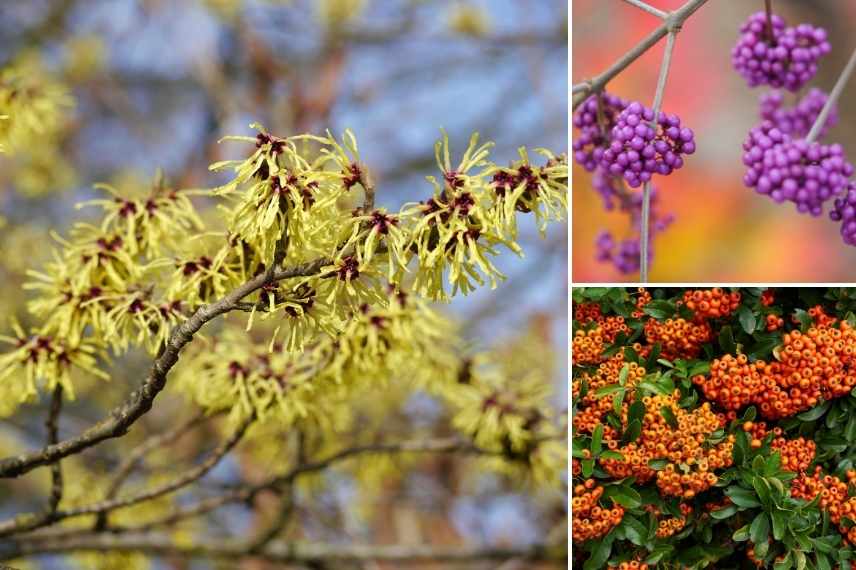
Add some zest to the garden with a Hamamelis mollis ‘Pallida’, the violet berries of a Callicarpa bodinieri, and the equally vibrant berries of an orange Pyracantha.
Spring sweetness
Callicarpa loses some of its charm when, in February, its berries disappear and its spring foliage is awaited. Accent the scene with winter heathers, such as ‘Springwood White’ with its white bells or Erica carnea ‘Jenny Porter’ with its pale pink flowering, and pair it with spring-flowering bulbs like botanical tulips that will take over when it is less spectacular.
Some Cyclamen coum or Hellebores, some of which flower very early (Hellebore nigercors ‘Emma®’, for example) will enliven its base in mid-winter. Also consider spring-flowering perennials like bleeding hearts with their heart-shaped white and pink flowers or summer bloomers like Heuchera ‘Wild Rose’, with its large purplish-pink leaves that will provide a decorative evergreen base all year round.
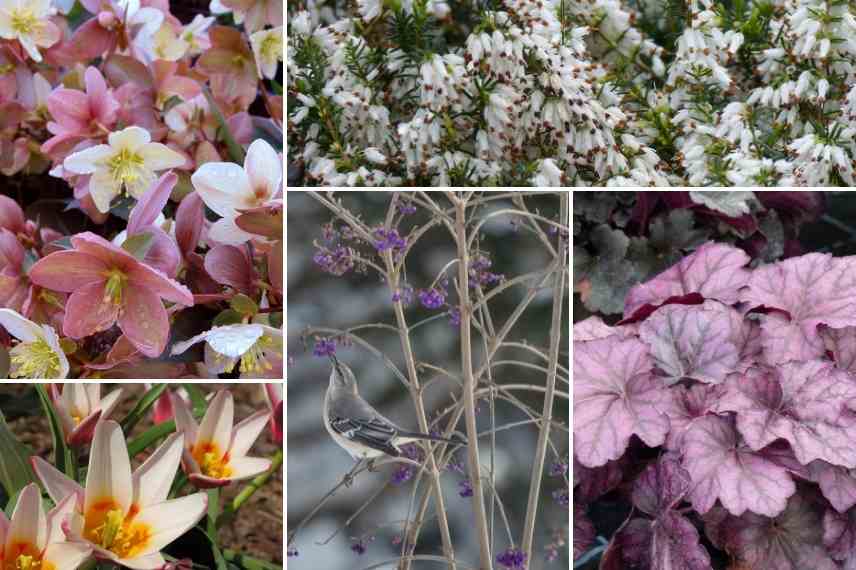
Surrounding a Callicarpa in winter, a Hellebore nigercors ‘Emma’, botanical tulips, a heather darleyensis ‘Springwood White’, and a heuchera ‘Wild Rose’
Discover other Callicarpa
View all →Available in 0 sizes
Available in 2 sizes
Available in 2 sizes
Available in 4 sizes
Available in 1 sizes
Available in 1 sizes
Available in 1 sizes
Available in 1 sizes
Available in 1 sizes
Available in 1 sizes
Summer festival
Later in the season, in the height of summer, around July, when the callicarpa is covered in small pale pink or white flowers, many other deciduous or evergreen shrubs, whether flowering or berry-bearing, will be welcome to accompany its subtle flowering. Bushy, graceful, and with a natural appearance, it displays fairly ordinary light green foliage in summer.
Consider botanical roses such as Rosa rugosa ‘Alba’, and white dogwoods to create a long-lasting floral and romantic atmosphere, along with Nandina domestica, ‘Albiflora’ spiraea, or even Cotoneaster franchetii with its evergreen foliage. Buddleias and mock oranges will bloom at the same time or slightly staggered depending on the variety, as will the viburnums, which are very accommodating.
On the perennial side, a Hosta ‘Sagae’ with green foliage variegated with yellow-cream, and an Achillea ptarmica ‘The Pearl’ will add elegance to the overall composition.
Be sure to stagger the flowering and foliage that will take over season after season, to maintain vibrant displays.
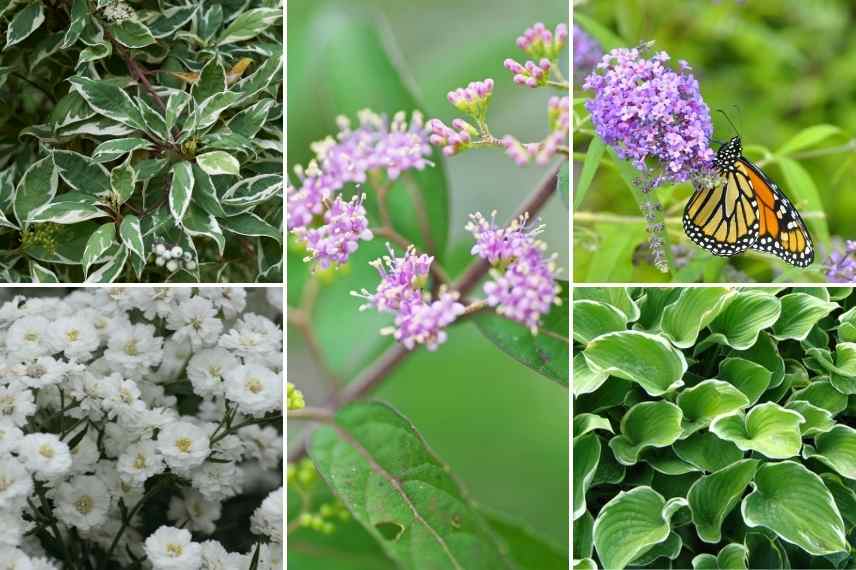
Callicarpa japonica in the centre, paired with the beautiful variegated foliage of Cornus alba ‘Elegantissima’, the immaculate white flowers of Achillea ptarmica ‘The Pearl’, the mauve of the buddleias, and the freshness of Hosta ‘Sagae’
Colourful autumn scene
In autumn, the deciduous foliage of the Callicarpa dons a cloak of a thousand shades. Its leaves turn to hues of yellow, orange, pink, red, or purple. They take on stunning tones at the end of the season, much like the Callicarpa bodinieri ‘Profusion’ and ‘Imperial Pearl’.
It will also create beautiful associations with evergreen shrubs that enhance contrasts, such as conifers and Elaeagnus ebbingei. Pair it with a European spindle whose foliage ignites in autumn and is also adorned with small bright orange berries, echoing those of the Callicarpa, or with a Euonymus alatus for the same reasons. Alternatively, consider the vermilion berries of cotoneasters, these shrubs are beautiful in all climates and any soil!
You can also plant your callicarpa alongside the pheasant tree, Leycesteria formosa with its plum-coloured fruits or the rowan, Sorbus aucuparia ‘Autumn Spire’, both equally decorative in foliage and berries.
In a shrub border, consider the Hydrangea quercifolia ‘Snowflake’, an original variety that tolerates lime and whose foliage takes on stunning reddish-brown hues in autumn. Then, focus on late-flowering perennials to intensify the display. Surrounded by autumn Asters like the Aster cordifolius ‘Idéal’ whose cool-toned small star-like flowers will contrast beautifully with the warm surrounding colours, Heuchera ‘Caramel’, and Sedums like ‘Orange Xenox’, all together will create a resplendent autumn ensemble.
Summer heathers like ‘Winter Chocolate’ will extend the appeal with their beautiful golden-yellow to bronze foliage, turning chocolate red in winter.
Accent the whole with some shimmering grasses, Miscanthus ‘Ghana’ or certain sedges like Carex comans ‘Bronze Form’.
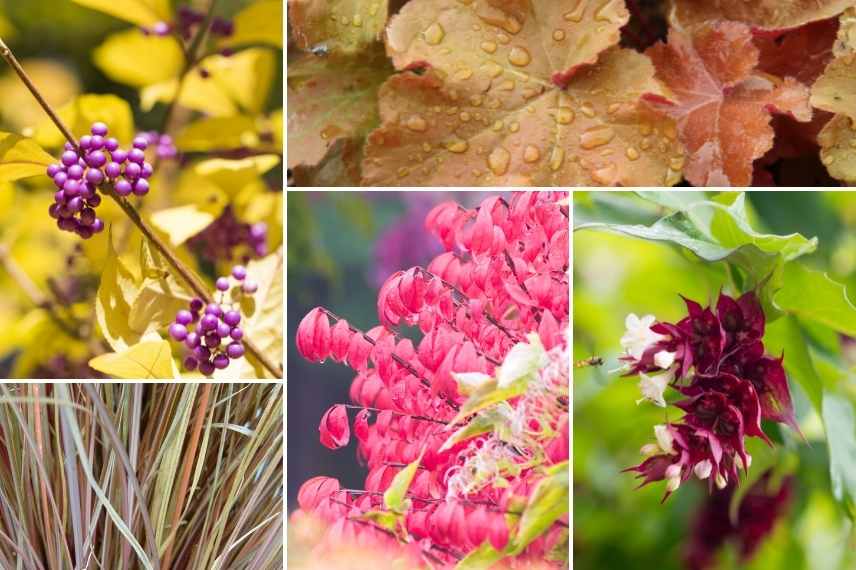
Callicarpa, Heuchere ‘Caramel’, Carex ‘Bronze Form’, Euonymus alatus, and pheasant tree (Leycesteria formosa)
Graphic variation
Callicarpa plays on all fronts, allowing for more graphic variations and striking contrasts.
It is in the heart of winter, when your Callicarpa still sparkles with its pearl-like, bright fruits, persistent along the bare stems, that this type of display will truly come into its own.
The purple berries of the Callicarpa will also be perfect for accompanying the decorative woods of dogwoods, such as the mahogany of Cornus alba ‘Kesselringii’, or the yellow-orange branches of Cornus sericea ‘Flaviramea’.
A purple-flowering Hamamelis, such as Hamamelis (x) vernalis ‘Amethyst’, will look stunning in its company, at the centre of a refined and colourful bed. A Hellebore ‘Madame Lemonnier’ with colours ranging from pink to dark purple will enhance them when planted nearby.
A few perennials and grasses will suffice to create contrast, such as Ophiopogon planiscapus ‘Nigrescens’, with its distinctly black leaves, or the Hakonechloa macra ‘Naomi’.
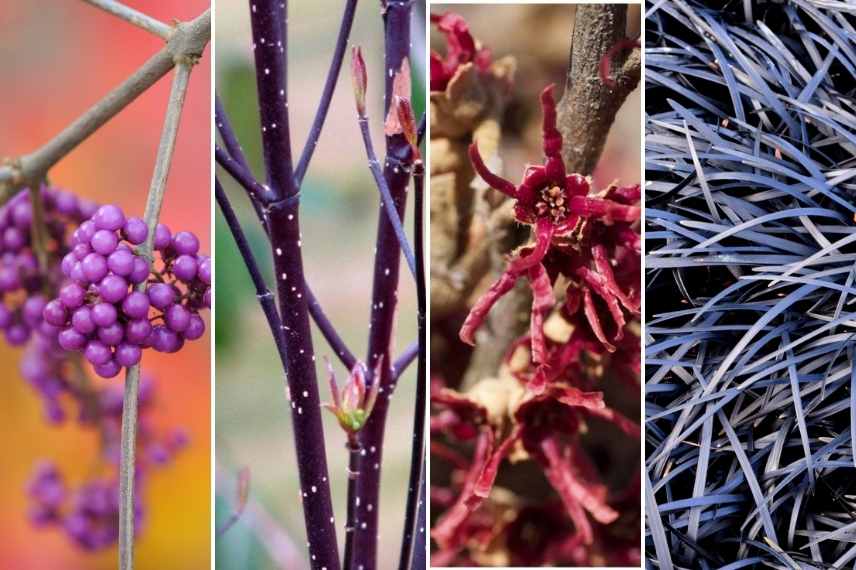
Callicarpa bodinieri, Cornus alba ‘Kesselringii’, Hamamelis x vernalis ‘Amethyst’ and Ophiopogon planiscapus ‘Nigrescens’
- Subscribe!
- Contents
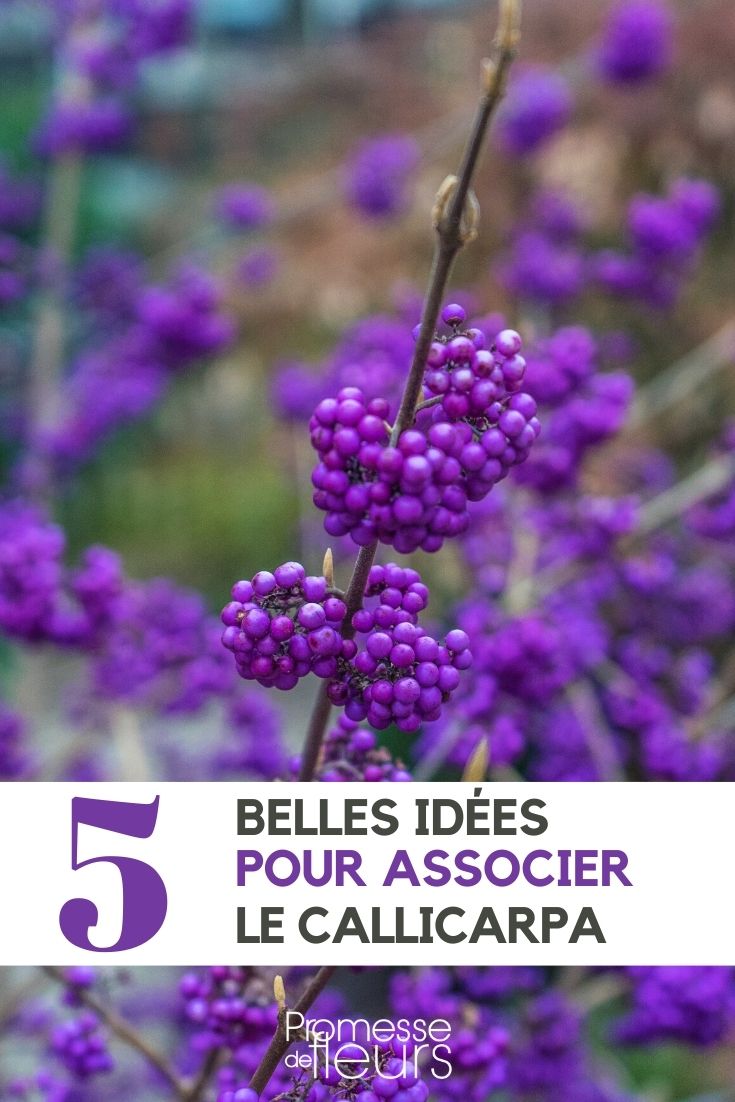
































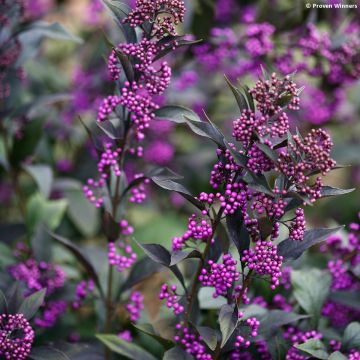
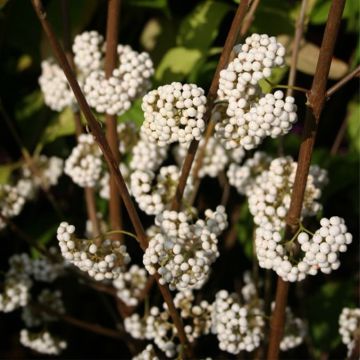
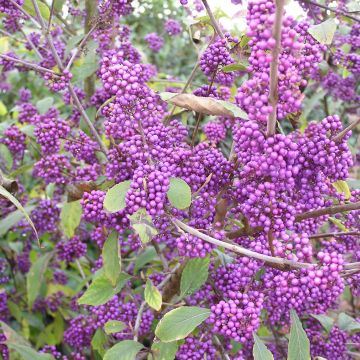

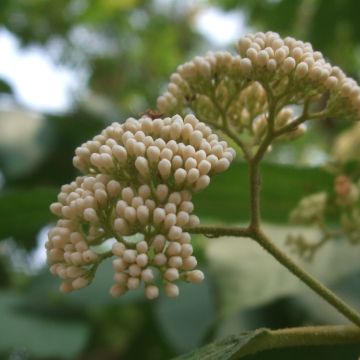

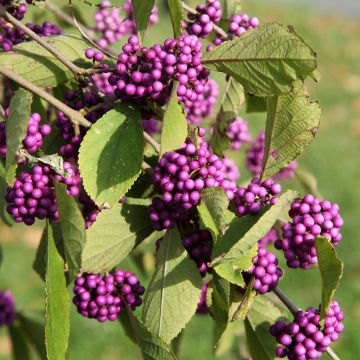

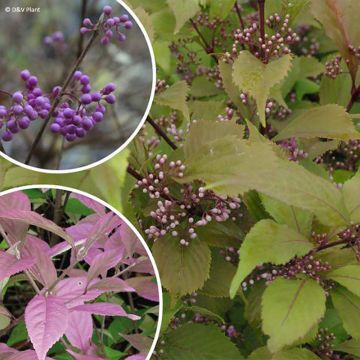
Comments